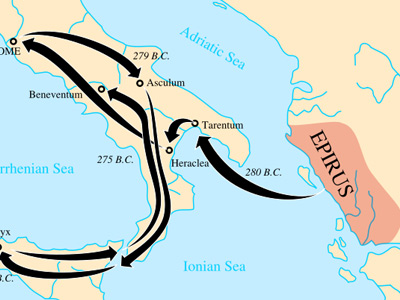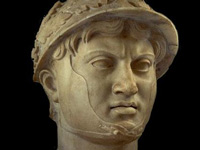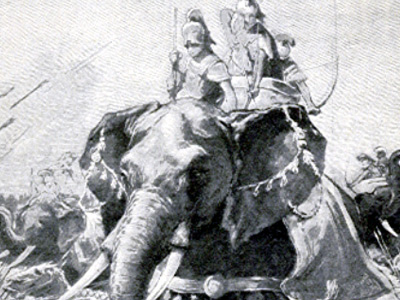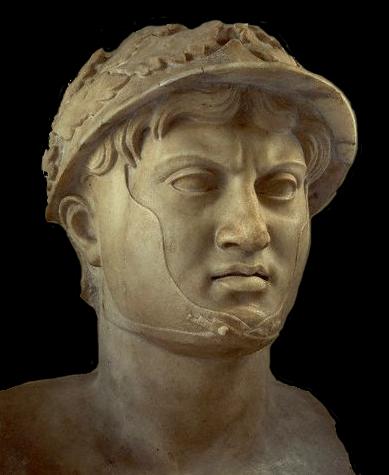Pyrrhic War (280–275 BC)

Return to Italy, Battle of Beneventum and End of the War
Plutarch wrote that the Carthaginian fleet confronted Pyrrhus when he was crossing the Strait of Messina to reach the mainland. He lost many ships in a naval battle. The Mamertine mercenaries, 10,000 of whom had crossed the strait, fought Pyrrhus in the mainland, threw his army into confusion and killed two elephants and many men in his rear-guard. Pyrrhus received a head wound, but managed to overcome the Mamertines. He arrived in Tarentum in the autumn of 276 BC with 20,000 men.
Dionysius of Halicarnassus did not mention a naval battle in the Strait of Messina. He wrote that the ships of Pyrrhus, who wanted to sail straight to Tarentum, met an unfavourable wind which lasted the whole night. Some ships were sunk. Some were swept to the Strait of Messina and others were driven ashore on the beaches of Locris. The crew of the ships beached near Locris died when they were submerged by the backwash of the waves. According to Dionysius, this happened because Pyrrhus, misled by one of his friends, Euegorus, and pushed by lack of funds, plundered the sacred treasure of the temple of the goddess Persephone, thus committing sacrilege. Dionysius did not specify where this took place. However, his narrative suggests that it occurred in Syracuse prior to setting off for Italy. The ships which were driven to the shores of Locris were the ones which were carrying the offerings to the goddess. When the waves broke the ships up, the sacred monies of the treasure were cast on the shore closest to Locris. Pyrrhus got scared and restored them to the goddess.
Appian mentioned the naval battle with the Carthaginians in the strait of Messina, but not the battle with the Mamertines on the mainland. In his account Pyrrhus took possession of the treasure of Persephone in Locris, after crossing from Sicily to Italy. He wrote that Pyrrhus had been a burden to the Greek cities because of the lodging and supplying of is troops, the garrisons he established, and the tribute he imposed. These exactions enriched him. When he left Sicily he set sail for Rhegium with ten ships and many cargo and merchant ships. The Carthaginians attacked him and sunk seventy ships and disabled the rest, except for twelve ships. He managed to escape and took vengeance on the city of Locris, whose inhabitants had killed the commander of his garrison there. He did much killing and plundering and grabbed the treasure of Persephone. He set sail again and got caught in a storm, which sunk some of his ships. All the sacred objects were swept to the beach of Locris. Pyrrhus restored them to the goddess and tried perform sacrifices in her honour. However, the sacrificial victims were inauspicious and he got angry. He executed those who advised him to rob the temple, had taken part in it or assented to it.
Cassius Dio wrote that when Pyrrhus went to Sicily the Romans The Roman Republic was a form of government of Rome and the era of the classical Roman civilization when it was run through public representation of the Roman people. Beginning with the overthrow of the Roman Kingdom (traditionally dated to 509 BC) and ending in 27 BC with the establishment of the Roman Empire, Rome's control rapidly expanded during this period - from the city's immediate surroundings to hegemony over the entire Mediterranean world. postponed their conflict with Tarentum. In 277 BC, the consuls Publius Cornelius Rufinus and Gaius Junius Bubulcus Brutus invaded and devastated Samnium. The Samnites took their most important treasures to the Cranita hills. The consuls tried to climb these hills, but they failed because they were overgrown with shrubbery, and so were defeated. Many of them died and many were taken prisoner. After this, the two consuls, blaming each other for the reverse, did not carry on the war together. Junius Bubulcus ravaged part of Samnium; Cornelius Rufinus attacked the Lucani and Bruttii and after this he took on Croton (which had revolted) at the invitation of some pro-Romans in the city. The anti-Roman faction asked Milo, the lieutenant Pyrrhus had left in Tarentum, for help. Milo sent Nicomachus who garrisoned the city. Unaware of this, Cornelius Rufinus approached the city walls carelessly and was defeated by a sortie. He sent two men to Nicomachus. They pretended to be deserters and claimed that the consul had given up on Croton and was advancing on Locris, which was being betrayed to him. Cornelius Rufinus pretended to be departing in haste. Nicomachus hurried towards Locris. Rufinus turned back undetected and seized Croton. Nicomachus went back to Tarentum, while Locris went over to the Romans. Like Appian, Cassius Dio wrote that Pyrrhus plundered the treasure of Persephone in Locris. However, according to him, he did so because his allies (presumably the allies in Italy) were unwilling to contribute anything to support him, whereas according to Appian, this was an act of revenge for the city going over to the Romans.
The Roman Republic was a form of government of Rome and the era of the classical Roman civilization when it was run through public representation of the Roman people. Beginning with the overthrow of the Roman Kingdom (traditionally dated to 509 BC) and ending in 27 BC with the establishment of the Roman Empire, Rome's control rapidly expanded during this period - from the city's immediate surroundings to hegemony over the entire Mediterranean world. postponed their conflict with Tarentum. In 277 BC, the consuls Publius Cornelius Rufinus and Gaius Junius Bubulcus Brutus invaded and devastated Samnium. The Samnites took their most important treasures to the Cranita hills. The consuls tried to climb these hills, but they failed because they were overgrown with shrubbery, and so were defeated. Many of them died and many were taken prisoner. After this, the two consuls, blaming each other for the reverse, did not carry on the war together. Junius Bubulcus ravaged part of Samnium; Cornelius Rufinus attacked the Lucani and Bruttii and after this he took on Croton (which had revolted) at the invitation of some pro-Romans in the city. The anti-Roman faction asked Milo, the lieutenant Pyrrhus had left in Tarentum, for help. Milo sent Nicomachus who garrisoned the city. Unaware of this, Cornelius Rufinus approached the city walls carelessly and was defeated by a sortie. He sent two men to Nicomachus. They pretended to be deserters and claimed that the consul had given up on Croton and was advancing on Locris, which was being betrayed to him. Cornelius Rufinus pretended to be departing in haste. Nicomachus hurried towards Locris. Rufinus turned back undetected and seized Croton. Nicomachus went back to Tarentum, while Locris went over to the Romans. Like Appian, Cassius Dio wrote that Pyrrhus plundered the treasure of Persephone in Locris. However, according to him, he did so because his allies (presumably the allies in Italy) were unwilling to contribute anything to support him, whereas according to Appian, this was an act of revenge for the city going over to the Romans.
When Pyrrhus returned to Italy in 275 BC, he fought the Battle of Beneventum against the Romans, which was to be the last battle of the war.
Plutarch gave the most detailed account of the battle. He wrote that during the three years Pyrrhus spent campaigning in Sicily the Samnites suffered many defeats at the hands of the Romans and lost a substantial part of their territory. This made them resentful towards Pyrrhus. Therefore, most of them did not join him when he returned to southern Italy. Cassius Dio wrote that the Samnites, being hard-pressed by the Romans, caused Pyrrhus to set forth again to come to their assistance. In Plutarch's account, Pyrrhus engaged the Romans despite the lack of Samnite support. The two consuls for 275 BC, Lucius Cornelius Lentulus Caudinus and Manius Curius Dentatus, were fighting in Lucania and Samnium respectively.
Plutarch wrote that Pyrrhus divided his forces into two divisions. He sent one of them against Cornelius Lentulus and marched with the other force during the night against Manius Curius, who was encamped near Beneventum and was waiting for help from Cornelius Lentulus. Pyrrhus was in a hurry to engage Manius Curius in case his colleague showed up. However, his soldiers lost their way and fell behind because he went a long way round through woods and his lights did not hold out. Dionysius of Halicarnassus wrote that Pyrrhus marched through "long trails that were not even used by people but were mere goat-paths through woods and crags, would keep no order and, even before the enemy came in sight, would be weakened in body by thirst and fatigue." This delayed Pyrrhus and at dawn he was in full view of the enemy as he advanced on them from the heights. Plutarch wrote that Manius Curius led his men out of the camp, attacked the enemy advance-guard and captured some elephants which were left behind. This success brought him to the plain, where he could engage Pyrrhus in battle on level ground. He routed some of the enemy lines, but an elephant charge drove him back to his camp. He called on the camp guards who were standing on the parapets of the rampart. They came down and threw javelins at the elephants, forcing them to turn round. They ran through the ranks of Pyrrhus, which were thrown into disarray, and, as a result, the Romans won the battle.
Dionysius of Halicarnassus wrote only one sentence about the battle: "When Pyrrhus and those with him had ascended along with the elephants, and the Romans became aware of it, they wounded an elephant cub, which caused great confusion and flight among the Greeks. The Romans killed two elephants, and hemming eight others in a place that had no outlet, took them alive when the Indian mahouts surrendered them; and they wrought great slaughter among the soldiers."
Cassius Dio also related the story of the wounded cub. He wrote that Pyrrhus was put to flight because "a young elephant had been wounded, and shaking off its riders, wandered about in search of its mother, whereupon the latter became excited and the other elephants grew turbulent, so that everything was thrown into dire confusion. Finally, the Romans won the day, killing many men and capturing eight elephants, and they occupied the enemy's entrenchments."
HISTORY

RESOURCES
This article uses material from the Wikipedia article "Pyrrhic War", which is released under the Creative Commons Attribution-Share-Alike License 3.0.
© Stories Preschool. All Rights Reserved.










